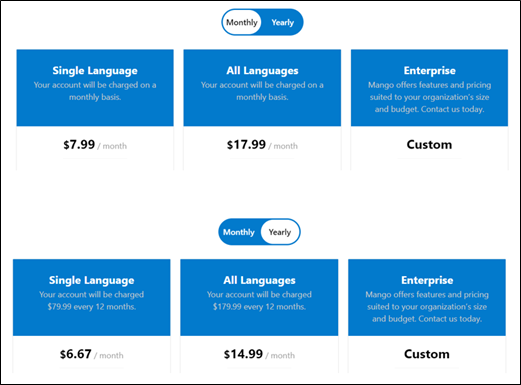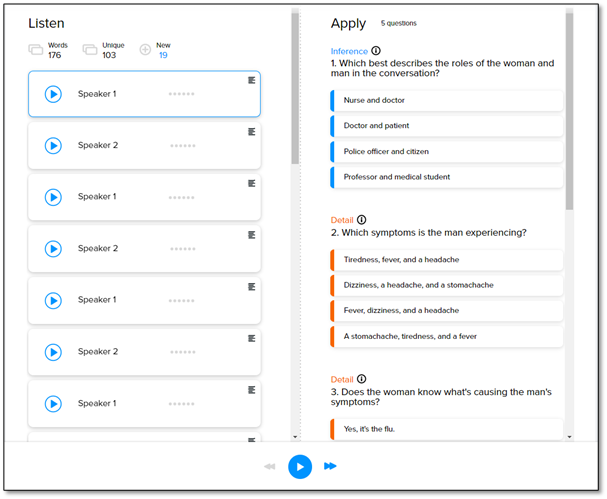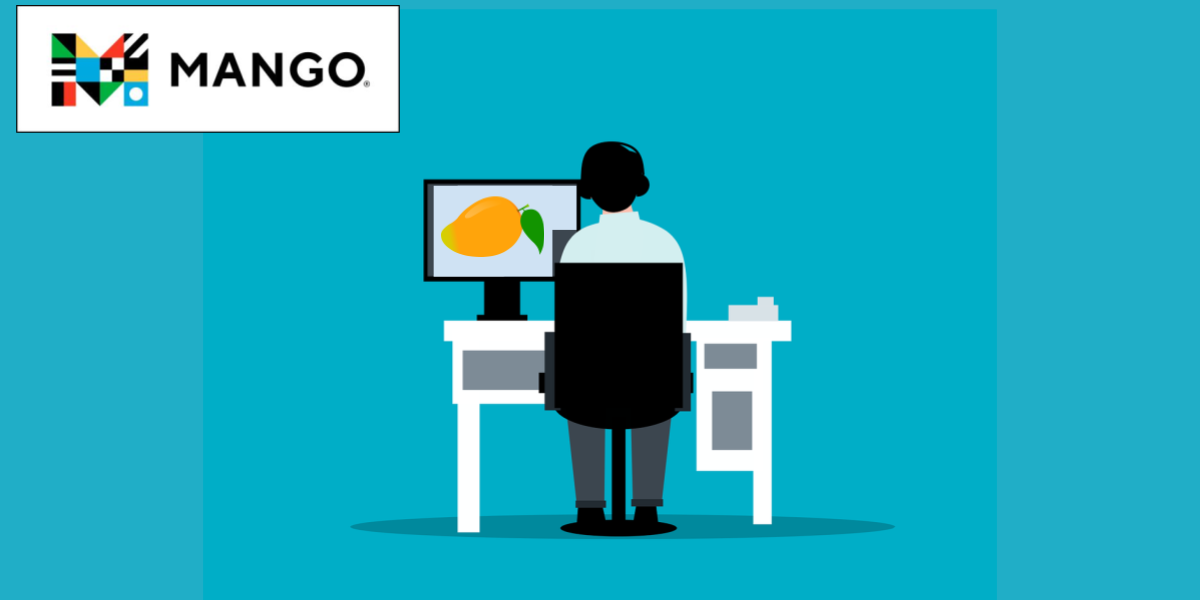Using Mango Languages in Self-Instructed Language Courses
By Anastasia Izmaylova, Grinnell College

DOI: https://www.doi.org/10.69732/TOFD9316
Many colleges and universities across the United States offer self-instructed language programs as a way to diversify their language offerings and support students interested in less commonly taught languages. Almost 30 institutions are listed as current members of National Association of Self-Instructed Language Programs. These programs have different names (e.g., alternate language study, directed independent language study, critical language program, etc.) and slightly different structures. However, many of them share the following characteristics: a common syllabus for students to follow, regular practice sessions with native speakers, and some form of accountability. One of the challenges of such programs is that the language offerings may vary from one semester to another based on students’ interests and native speaking tutor availability. There are different ways to find native-speaking tutors: some programs hire people from the community, others rely on graduate students, and yet others hire peer tutors from the international and bilingual student population. In our program, we use the peer tutor model, employing mostly undergraduate international students for this role. In addition to these variations, students often express interest in a particular language very close to the beginning of the semester. Under these circumstances, program directors need to be able to find instructional materials and create a syllabus in a very short period of time. As a new director of a self-instructed language program, I attempted to overcome this challenge by using Mango Languages as the primary instructional material for the first semester of all languages in the program. In this article, I will highlight the different features of Mango Languages and explain how these features make the platform useful for independent learners.
What is Mango Languages?
Mango Languages is an online language learning platform that is designed for independent learners. It has a user-friendly interface and is available as a desktop website and a mobile app, which allows users to seamlessly switch between the two and learn on the go. It offers over 70 languages, ranging from some commonly taught (e.g., Spanish and French) to indigenous and endangered languages (e.g., Cherokee and Potawatomi). Overall, it is a practical program that focuses on everyday conversational skills. While the amount of content and topics vary among languages, there is a relative consistency in the type of material presented to learners. The first unit typically follows the same topics throughout the chapters, starting with small talk and salutations and expanding into a number of topics that would be helpful for an individual who finds themselves in a place where the target language is spoken, such as asking for directions, asking for help, and negotiating meaning by clarification.
Mango Languages offers monthly and yearly paid subscriptions for individual users with access to one or all languages, as illustrated below. The enterprise prices vary on the estimated number of users as well as the duration of the contract.

Mango Languages does not explicitly ascribe to any particular second language acquisition theory or methodology, but rather calls their method the “intuitive language construction™”. Within this method, the program is focused on vocabulary, grammar, pronunciation, culture, comprehension, and retention. It claims to “adapt to [an individual’s] unique learning style, so [they] pick up on new vocabulary, intuit unfamiliar grammatical structure, and train [their] pronunciation, all while boosting [their] cultural IQ.” Mango Languages uses what they call a conversation-based methodology, where the lesson material is presented through a conversation that is then deconstructed throughout the lesson and eventually reconstructed by the learner. These features, along with the primacy of audio materials are somewhat reminiscent of the audiolingual method and aligned with the Input Hypothesis (Krashen, 1976), albeit not overtly.
Mango Lesson Design
The unit and chapter design are straightforward and based on constant repetition. It allows users to skip any parts, from individual lessons to chapters, and go out of order, allowing for customization of the curriculum. When an existing user logs in, they are offered daily review cards to ensure that the previously learned material stays fresh in their mind.
Each chapter begins with an overview of the conversational and grammar goals. Then the lesson material is presented through a dialogue. Learners listen to the dialogue while following its transcription and English translation. Next, the dialogue material is deconstructed through the presentation of new vocabulary, grammar, and culture notes. Each lesson within the chapter is focused on specific words and expressions that are provided to the learner and tested at various intervals. While separate sounds are not studied, all words get transliterated when a user hovers over them with the cursor. Vocabulary retention is reinforced through “memory-building” and “critical thinking” exercises, which are word translations, sentence creations using words given in the target language, and phrase and sentence translations. Teaching grammar is approached indirectly with little to no explanation of rules. Instead, brief grammar notes are used for clarification. Similarly, short culture notes demonstrate various aspects of “little c” culture, such as common phrases, customs, and behaviors.
The screenshot below represents a typical vocabulary-focused slide, where the word is translated in the understood and literal meanings. The understood meaning is the one shown by default, and students have an option to see the literal meanings by using the toggle above the word. While no explanation is given on the difference between the two meanings, students encounter the word in its understood context all the time throughout the lesson, making it clear that it is the primary meaning of the word. When a learner hovers over the word, its transliteration appears helping the learner understand the pronunciation of the word. The orange microphone icon allows students to record their voice and compare their voice pattern to that of a native speaker. The green speaker icon and replay icons allow students to replay the word pronunciations.

In the next image you see sentences in Brazilian Portuguese and their English translation with the corresponding words and phrases highlighted in the same color. The grammar note following the sentence briefly explains the use of the conjunction “because”.

Finally, the screenshot below shows two examples of culture notes. The first one describes a common form that all tourists would need to fill out at a hotel in Brazil. The second one is an example of language-focused cultural information that describes when to use a particular greeting in Russian.

Each chapter concludes with a chapter recap, where learners can choose the type of questions on which they want to focus – speaking, listening, reading, or any combination of the three. In some languages, there are listening, reading, and post-chapter quiz sections following the recap. In the next screenshot you see part of a listening activity. Learners listen to a dialogue and answer comprehension questions that focus on general inference and more detailed information. All the phrases have transcriptions available as needed.

Reading activities are structured similarly to listening activities. Learners read an excerpt and answer questions on the main idea and details about the text. The text can also be listened to, and each word has a pronunciation guide available. Finally, chapter quizzes consist of listening to a dialogue and answering multiple-choice questions based on the content of that dialogue, building sentences with given words, and answering cultural questions. Learners can take the quizzes as many times as they want, with all their attempts recorded. They are also able to review their answers and compare them to the answer key.
Mango Languages as the Main Course Material
In our program, about 30 students enroll in self-instructed language study per semester, earning 1-2 credit hours. The most popular languages are Brazilian Portuguese and Korean, with multiple levels of both languages offered every semester. Other language offerings vary depending on student demand. In this academic year, students have studied Italian, Thai, Turkish, Urdu, and Vietnamese. In the Fall, we will offer Hindi, Modern Greek, Romanian, and Ukrainian. Depending on the number of languages and sections offered, every semester 4-10 peer tutors are hired to lead communicative class sessions.
We have acquired an institutional license to Mango Languages primarily for the program, but it is also available to all faculty, staff, and students for independent learning. While Mango Languages is not an equivalent to a textbook in a regular language course, it can be an excellent resource for a self-instructed language program thanks to its clear structure and organization, as well as the ability to track learners’ activity. Its contents are divided into units, chapters, and lessons, making it convenient to map the learning materials onto the semester schedule. On average, one chapter per week in the first unit is a feasible amount of material to cover. The chapter goals are also helpful if one wishes to supplement Mango Languages with other instructional materials.
Users can easily track their activity on the platform by viewing dates and times of all their learning sessions, and see how much time they have spent on each of those sessions, and which units, chapters, and lessons they have covered. Wherever quizzes and tests are available, users can also generate an assessment report that includes the date and time they took the quiz, their score, and their answers along with the answer key.
Administrative access also provides numerous insights into platform usage. Account administrators can view the total number of users and overall learning sessions, the number and duration of sessions over any period of time, average learning times, and the breakdown of that information by language. In addition, administrators have access to all individual users’ activity on the platform. There is also an option of setting up groups of users into “classrooms”, which provides average statistics for each group and makes looking at each language cohort’s activity quick and convenient.
What Do Students Say?
Student feedback for Mango Languages varies based on their individual preferences and the languages that they study. Some of the positive comments include that the program is helpful in building vocabulary and is generally conducive to learning due to the constant repetition and reinforcement. They also mention that the platform is helpful in combination with their own notetaking and the in-class practice sessions. Finally, some students consider it fun to learn a language through Mango, and others mention the usefulness of the cultural information that is often absent on other learning programs and apps.
As for the platform drawbacks, students most often mention how tedious the constant repetition can get and the overwhelming amount of material assigned. In our program, it is typical to have one chapter assigned per week, with the expectation that students distribute their learning throughout the week. However, the self-directed nature of the program requires students to hold themselves accountable to those regular study sessions and they often struggle to set aside the necessary time to stay on top of their assignments. This is, of course, not a negative aspect of the platform itself, but rather a caveat of any independent learning method. Another negative comment related to the platform itself is the organization of grammar information. Students often want more explicit and clearly structured grammar instruction. Finally, students deem some content outdated and, thus, not very useful. For instance, the chapter on Places and Directions contains expressions on how to buy a map, which students considered irrelevant due to the ubiquitous use of map applications on smartphones. Native-speaking tutors have also noted that the choice of vocabulary for each topic seemed haphazard at times, with high-frequency words and expressions not presented where they would have expected them to be.
Do Students Learn?
Over the last three semesters, students’ oral skills at the end of the program were evaluated using the Oral Proficiency Interview (computer). After ten weeks in Korean 1, more than half of the students achieved the Novice-High proficiency level, very few got to the Intermediate-Low, and the rest reached Novice-Mid. At the end of the ten-week program in Brazilian Portuguese 1, half of the students reached Intermediate-Low proficiency level. Among the other half of the students, those with no other Romance language knowledge reached Novice-High, while students with some degree of Spanish language knowledge achieved higher levels in the Intermediate range. We cannot attribute this attainment solely to Mango Languages as students engaged weekly in three hours of communicative sessions with native speaking peer tutors and their classmates. However, these results do show that the combination of Mango Languages with speaking practice allows learners to achieve oral proficiency levels that would be expected for the amount of time they dedicated to learning.
Conclusion
Overall, Mango Languages is a great resource for anyone looking to gain beginner to low intermediate language skills, especially if they are learning the language in anticipation of traveling or studying abroad. While it has some challenges, such as a repetitive nature and a narrow focus of lessons, it is also a useful platform for self-directed language programs. Some of the benefits for students include the ease of access to the platform from any device and a user-friendly interface. It is also affordable for individual students or even free of charge once an institutional license is acquired. The platform provides multimodal input with ample and frequent repetition, as well as regular self-assessment opportunities. There are also organizational benefits for the instructors or administrators of self-directed platforms, such as instant access to numerous language courses with a similar built-in syllabus and easy monitoring of student activity and progress. Combined with regular conversational practice, using the platform can lead to consistent language skill development.

